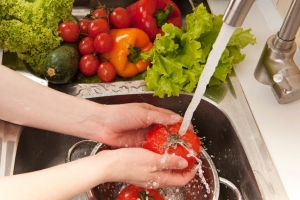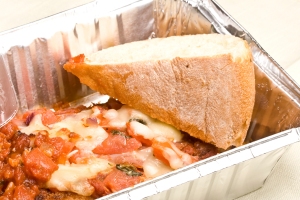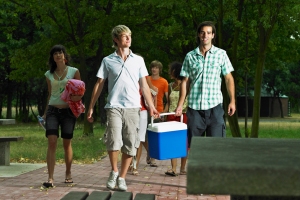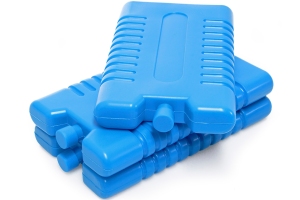 While fresh fruits and vegetables are great for your health, many people don’t wash them before eating and this can cause foodborne illness. Washing helps decrease bacteria and viruses from soil and other sources that cause illness. Always use running water to wash fruits and vegetables just before you plan to use them or eat them. For produce with hard skins such as melons and potatoes, use a vegetable brush to gently rub the skin. Be sure to clean the brush between uses. Use your hands to rub leaves and stalks to remove any hidden dirt. Wash foods even if you plan on peeling them. Bacteria and viruses can easily get inside the food when you peel it. Stay healthy by washing your fruits and vegetables!
While fresh fruits and vegetables are great for your health, many people don’t wash them before eating and this can cause foodborne illness. Washing helps decrease bacteria and viruses from soil and other sources that cause illness. Always use running water to wash fruits and vegetables just before you plan to use them or eat them. For produce with hard skins such as melons and potatoes, use a vegetable brush to gently rub the skin. Be sure to clean the brush between uses. Use your hands to rub leaves and stalks to remove any hidden dirt. Wash foods even if you plan on peeling them. Bacteria and viruses can easily get inside the food when you peel it. Stay healthy by washing your fruits and vegetables!
Category Archives: Food safety
Dining out and leftovers
 Many restaurants serve large portions, and people often take leftovers home. Eating leftovers is a good way to stretch your food dollar but it is important to keep the food safe. When you take leftovers with you from a restaurant, go home right away so you can put the food in the refrigerator. If you can’t go home soon after eating, bring along a cooler with ice or freezer packs for your leftovers. Or you can always order less food or split a meal so you don’t have any leftovers. You’ll save money and you won’t have to worry about your leftovers spoiling. Be smart about restaurant leftovers and keep your food safe!
Many restaurants serve large portions, and people often take leftovers home. Eating leftovers is a good way to stretch your food dollar but it is important to keep the food safe. When you take leftovers with you from a restaurant, go home right away so you can put the food in the refrigerator. If you can’t go home soon after eating, bring along a cooler with ice or freezer packs for your leftovers. Or you can always order less food or split a meal so you don’t have any leftovers. You’ll save money and you won’t have to worry about your leftovers spoiling. Be smart about restaurant leftovers and keep your food safe!
Food safety at home events
 Keeping food safe is always a concern, but it’s especially important in the summer heat when bacteria grow more quickly. One key to food safety in the summer is to keep hot foods hot and keep cold foods cold. If you are at an event like a barbecue, decrease the time that foods are left out by putting food out in smaller batches so it stays hot or cold. Use a cooler to keep foods cold and keep the cooler in the shade or under a tree. If you don’t have a cooler, you can put food on ice: fill a big bowl with ice and then put the serving bowl of food over the ice. Stay safe this summer by keeping cold foods cold and hot foods hot!
Keeping food safe is always a concern, but it’s especially important in the summer heat when bacteria grow more quickly. One key to food safety in the summer is to keep hot foods hot and keep cold foods cold. If you are at an event like a barbecue, decrease the time that foods are left out by putting food out in smaller batches so it stays hot or cold. Use a cooler to keep foods cold and keep the cooler in the shade or under a tree. If you don’t have a cooler, you can put food on ice: fill a big bowl with ice and then put the serving bowl of food over the ice. Stay safe this summer by keeping cold foods cold and hot foods hot!
Using insulated shopping bags
 Have you ever seen reusable, insulated shopping bags at the grocery store? They help keep cold foods cold, which prevents the foods from going bad too soon. These bags are a great investment, especially if it takes you a long time to get home from the store. If you avoid buying cold foods because you can’t keep them cold on the way home, then these bags will give you more food options. The bags work especially well if you bring ice packs or buy frozen food at the store. Some stores will even give you a discount every time you use the bag. They’re easy to clean, and you should clean them often if you use them for meat. Save money and keep foods safe by keeping your cold foods cold!
Have you ever seen reusable, insulated shopping bags at the grocery store? They help keep cold foods cold, which prevents the foods from going bad too soon. These bags are a great investment, especially if it takes you a long time to get home from the store. If you avoid buying cold foods because you can’t keep them cold on the way home, then these bags will give you more food options. The bags work especially well if you bring ice packs or buy frozen food at the store. Some stores will even give you a discount every time you use the bag. They’re easy to clean, and you should clean them often if you use them for meat. Save money and keep foods safe by keeping your cold foods cold!
First in, first out
 Thanksgiving is this week, and you’ll probably have some leftovers. “First in, first out” is one of the best ways to prevent food spoilage. It just means to rotate your foods so the older items are right in front. That way you’ll use them first, and you won’t discover them weeks or months later, covered with mold. Put fresher things in the back as soon as you stock up on groceries. And if you cook ahead to use leftovers, keep track of what you have and use the oldest foods first. Watch dates on refrigerated foods like milk and yogurt, and write the name and date on everything you freeze. Avoid having to throw spoiled foods away —“First in, first out” can save you money and frustration.
Thanksgiving is this week, and you’ll probably have some leftovers. “First in, first out” is one of the best ways to prevent food spoilage. It just means to rotate your foods so the older items are right in front. That way you’ll use them first, and you won’t discover them weeks or months later, covered with mold. Put fresher things in the back as soon as you stock up on groceries. And if you cook ahead to use leftovers, keep track of what you have and use the oldest foods first. Watch dates on refrigerated foods like milk and yogurt, and write the name and date on everything you freeze. Avoid having to throw spoiled foods away —“First in, first out” can save you money and frustration.
Saving with your refrigerator
 Did you know that your refrigerator can save you money? It can, by keeping foods at safe temperatures so they last longer! Keep your refrigerator at or below 40 degrees Fahrenheit, and your freezer at 0 degrees Fahrenheit. Get an inexpensive refrigerator thermometer and check it every so often – it’s worth it! Then use your refrigerator to keep foods cold. Refrigerate or freeze foods as soon as possible when you get home from the store. And refrigerate leftovers in small, flat containers within 2 hours of cooking – even if they are still hot. For more information about storing foods safely, go to the website, www.foodsafety.gov. Watch the temperatures — a good refrigerator can be a great money-saver!
Did you know that your refrigerator can save you money? It can, by keeping foods at safe temperatures so they last longer! Keep your refrigerator at or below 40 degrees Fahrenheit, and your freezer at 0 degrees Fahrenheit. Get an inexpensive refrigerator thermometer and check it every so often – it’s worth it! Then use your refrigerator to keep foods cold. Refrigerate or freeze foods as soon as possible when you get home from the store. And refrigerate leftovers in small, flat containers within 2 hours of cooking – even if they are still hot. For more information about storing foods safely, go to the website, www.foodsafety.gov. Watch the temperatures — a good refrigerator can be a great money-saver!